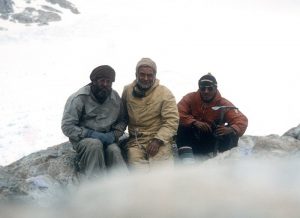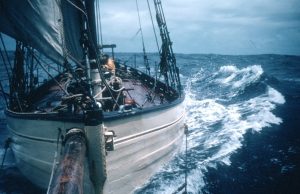In 1953, after a brief and unsatisfying stint as a British consul in Myanmar, then Burma, Bill Tilman decides to return to the mountains, this time using the sea as his preferred approach route. In his preface to ‘Mischief in Patagonia’, he writes:
“The approach to one’s chosen mountains is sometimes as interesting as the mountains themselves. Our approach to the mountains of Patagonia, by way of a sea voyage of some 10,000 miles, for the sake of traversing 50 miles of glacier, may seem a little long. So long that some readers may think there is an intolerable deal of sea, as it were, to but one halfpennyworth of mountain.”
The book begins with his development of the theme of ‘sailing to climb’, an expedition form which in the 21st century is becoming increasingly popular but which, in no small part, owes its existence to the account written in this book.
“Proverbially it is not easy to blow and swallow at the same time. So also it is not easy to combine mountaineering and sailing. There are, however, one or two places where such a thing can be done. In the Lofoten Islands a man can sail to the foot of his chosen rock face. On the southernmost coast of Chile, where the high Andes begin to dwindle, there are glaciers reaching down to the sea where a mountaineer can step from his boat and begin his climb at sea-level. A region such as this has an irresistible attraction for a mountaineer who, late in life, catches sea fever and aspires to making an ocean voyage in his own boat. These Chilean glaciers have their origin in the Patagonian ice-cap (Hielo Continental as it is known there). This covers some 400 or 500 miles between 44° and 51° S., and varies in width from 20 to 50 miles and in height from 6000 to 10,000 ft. I first heard of its attractions in 1945, just after the war, from a friend who had learnt of it while a prisoner in Germany. For the most part the ice-cap was unexplored. No one yet had crossed it, and its glaciers, besides coming so conveniently down to the sea, had other strangely attractive features. Trees grew upon them—one felt this must be an exaggeration. Humming birds and parrots nestled in their branches and penguins paced the ice beneath. On the Argentine side of the range—the accepted way of approach—there were great lakes and forests, and beyond those to the east there were the rolling pampas where millions of sheep roamed, attended by gaucho shepherds, wild characters who lived on meat and maté tea, and rode down ostriches with whirling bolas.
The more prosaic details of this glowing account were confirmed by the best map then available, the 1 to 1,000,000 sheets of the American Geographical Society. This showed two white, blank spaces bearing the magic word ‘inesplorado’. On these two blank spaces, the northern and southern parts of the ice-cap divided by the Rio Baker, were shown numerous glaciers descending to the Patagonia Channels on the west, and to the great lakes of Argentino, Viedma, San Martin, and Buenos Aires on the east.”
Thus was born the germ of an idea. Not only did the maps of the day in the 1950s still show large, remote areas which remained unexplored and consequently un-mapped, but in the higher latitudes, these areas often gave access to unclimbed glaciers and peaks. In the case of the numerous islands of the Arctic and the Antarctic, these destinations could normally only be reached after long voyages, the most practical, cost effective mode of transport being a small, sturdily built, sailing ship.
“Before this line of thought had led me anywhere I had acquired a stout 14 ft. dinghy as a first step to venturing upon the sea. There are a number of mountaineers whose devotion to mountains is not entire, who own and sail boats; but there are few sailors who also climb. Of these, the best known was the late Conor O’Brien. He was a celebrated yachtsman who had designed his own yacht Saoirse. Having been invited to join a climbing party in the New Zealand alps for Christmas in 1923 he thought a voyage there an excellent opportunity for trying her out. Going by the Cape and running his easting down in the Roaring Forties he reached New Zealand. He arrived too late for any climbing so he sailed home by way of the Pacific and Cape Horn. One feels that his devotion to the sea came first and that in his eyes the loss of a climbing season was nothing to the accomplishment of such a tremendous voyage.”
As Tilman develops his justification for this new form of expedition, sailing to climb, he draws parallels between climbers and sailors.
“There is something in common between the arts of sailing and of climbing. Each is intimately concerned with elemental things, which from time to time demand from men who practise those arts whatever self-reliance, prudence, and endurance they may have. The sea and the hills offer challenges to those who venture upon them and in the acceptance of these and in the meeting of them as best he can lies the sailor’s or mountaineer’s reward. An essential difference is, perhaps, that the mountaineer usually accepts the challenge on his own terms, whereas once at sea the sailor has no say in the matter and in consequence may suffer more often the salutary and humbling emotion of fear.”
The early part of the book covers his purchase of Mischief, the 1904 vintage former Bristol Pilot Cutter, and his early experience of the difficulties associated with finding the right crew. On at least one occasion this leads to his first experience of what he would come to term in later years a ‘polite mutiny’. Once provisioned and with a full crew, Mischief set sail south to the Antarctic from Lymington in Hampshire, the Solent port which would become Tilman’s sailing base for the rest of his days.
On arrival in Patagonia, the ship’s company was divided into two parts, the shore party leaving to make the crossing of the icecap while the remainder of the crew, shorthanded, took the boat back on a not uneventful trip through the hostile waters of the Strait of Magellan to pick up the climbing party on ‘the other side’. What sounds simple enough in that single sentence belies the complexity and danger associated with this undertaking.
“I will not pretend that at all times throughout this 20,000 mile voyage we were a band of brothers. Patient Griselda herself and a company of angels would sometimes find their tempers strained to breaking point when cooped up in a small ship for months together. ‘Ships are all right—it’s the men in them’, was, I suspect, the thought of each one of us on many occasions; and I know for certain of a few occasions when the same idea was openly and more pointedly expressed. But we were old enough or sensible enough to bear and forbear, and to put the ship and the enterprise in hand before our own feelings. It was this loyalty to the ship, and not my management, that held the crew together and enabled us to bring a worthwhile undertaking to a successful end.”

Charles Marriott, H.W. Tilman and Jorge Quinteros – the shore party on the crossing of the Patagonian icecap.
From the Foreword by Sir Robin Knox-Johnston:
“His voyage to South America to cross the ice cap is one of the great sailing and exploration adventures. He describes the passage through the Magellan Strait in straightforward terms but, as those of us who have sailed in those channels know, it is a dangerous route with almost constant, cold adverse winds for the west-going vessel, of Force 7 or more. Despite this he achieved his objective and returned via the Panama Canal, a voyage of some 20,000 miles. In his amusing style of writing he describes the vicissitudes in a casual way that belies what he really achieved.”
Extracts from ‘Mischief in Patagonia‘ by H.W. Tilman.
First published by Cambridge University Press in 1957.
Revised edition by Tilman Books, 2015.
The full Collected Edition of Tilman’s books are available from Lodestar Books.


